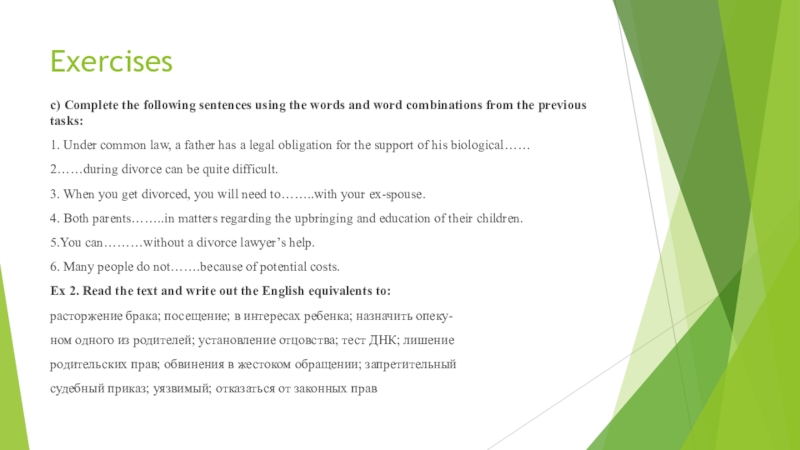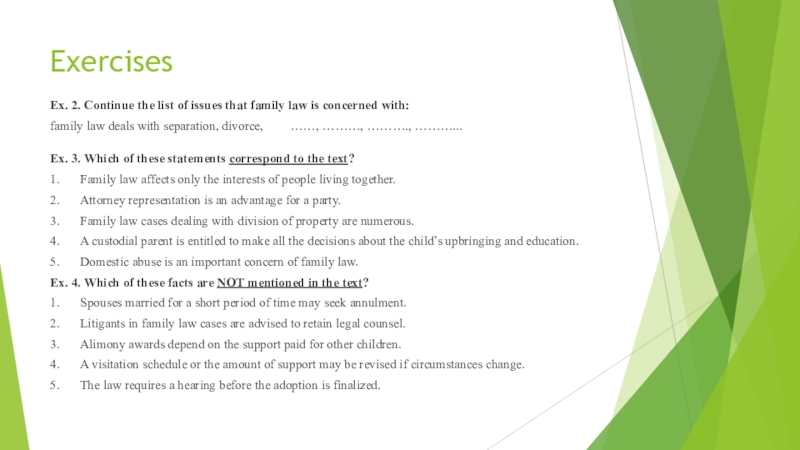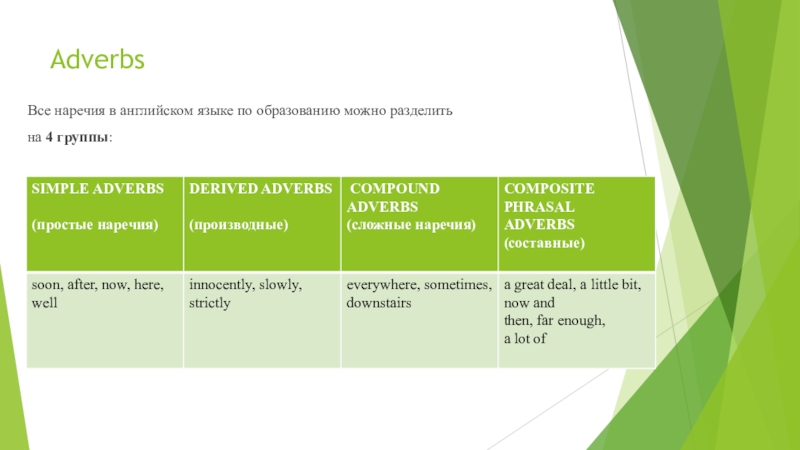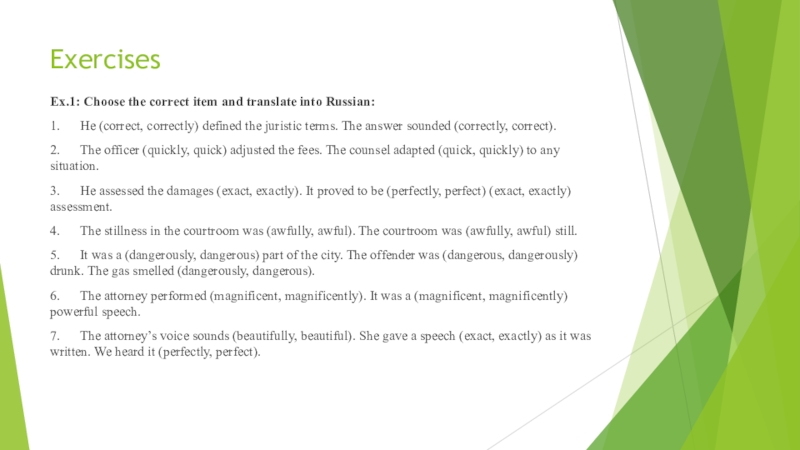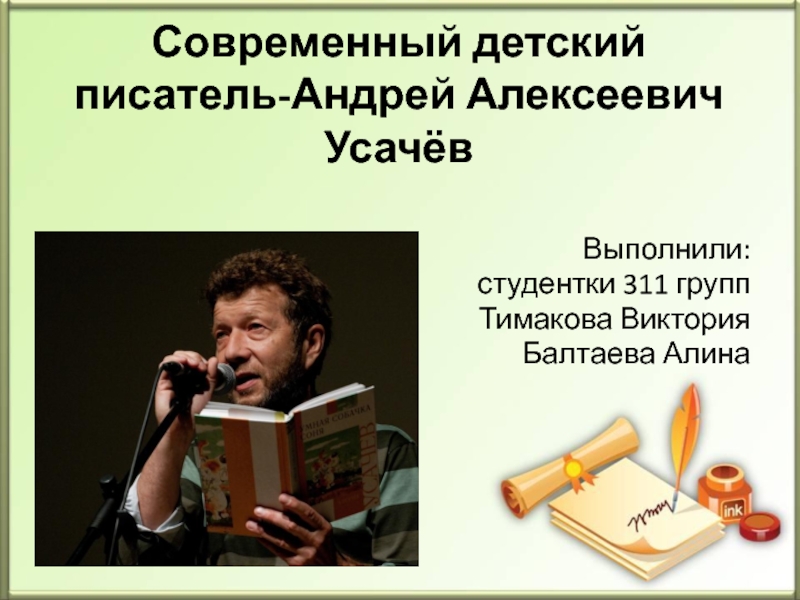Слайд 2Key Words and Word Combinations
Слайд 4Exercises
Exercise 1. a) Match the synonyms:
1 property
a. to influence
2 prenuptial b. assets
3 to affect c. children
4. troubled family d. premarital
5. offspring (singular and plural) e. at-risk family
b) Make word combinations and translate them into Russian:
1. to reach a. for separation or divorce
2. division b. an agreement
3. to have c. of property
4. to file d. from a lawyer
5. to seek advice c. an equal say
Слайд 5Exercises
c) Complete the following sentences using the words and word
combinations from the previous tasks:
1. Under common law, a father
has a legal obligation for the support of his biological……
2……during divorce can be quite difficult.
3. When you get divorced, you will need to……..with your ex-spouse.
4. Both parents……..in matters regarding the upbringing and education of their children.
5.You can………without a divorce lawyer’s help.
6. Many people do not…….because of potential costs.
Ex 2. Read the text and write out the English equivalents to:
расторжение брака; посещение; в интересах ребенка; назначить опеку-
ном одного из родителей; установление отцовства; тест ДНК; лишение
родительских прав; обвинения в жестоком обращении; запретительный
судебный приказ; уязвимый; отказаться от законных прав
Слайд 6Exercises
WHAT IS FAMILY LAW?
Family law consists of a body of
statutes and case precedents that govern the legal responsibilities between
individuals who share a domestic connection.
These cases usually involve parties who arc related by blood or marriage, but family law can affect those in more distant relationships as well.
The vast majority of family law proceedings come about as a result of the termination of a marriage, family law attorneys help their clients file for separation or divorce, alimony, and child custody, visitation, and support. The division of property at the end of the marriage is also a common issue in family law cases. Courts will enforce prenuptial agreements and distribute assets and financial support accordingly.
The issue of child custody is the most common dispute in family court. Judges will always decide custody based on the best interest s of the child". The court may assign legal and physical custody to one parent, or those rights can be shared. A typical schedule would allow the child to spend weekends, summers, and alternating holidays with non-custodial parent, with both parents having an equally in major decisions affecting the child. All parents have a legal duty to provide financial support for their children. Alimony awards will be calculated in each particular case taking into account the respective incomes of the parents.
Family law cases can involve a number of other matters. Establishing (or disproving) paternity is a common subject of litigation, although it is becoming less complicated with the ability of courts to order DNA testing. Other issues include the termination of parental rights, adoption and grandparent rights. Family law also deals with the prevention of physical and emotional abuse. When allegations of abuse are made, the court will typically issue a restraining order to prevent further contact. Family law addresses the problems of ‘troubled families' that are characterized by child neglect and run a risk of generating juvenile delinquency.
Family law in the 21st century is evolving quickly, making it more important than ever to seek advice from a qualified attorney. Without attorney representation a party is vulnerable and can unknowingly waive important legal rights.
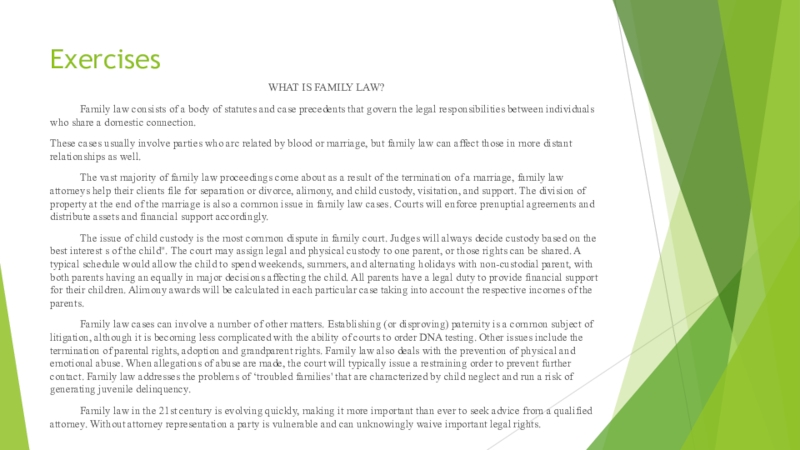
Слайд 7Exercises
Ex. 2. Continue the list of issues that family law
is concerned with:
family law deals with separation, divorce, ……, ………, ……….,
………...
Ex. 3. Which of these statements correspond to the text?
1. Family law affects only the interests of people living together.
2. Attorney representation is an advantage for a party.
3. Family law cases dealing with division of property are numerous.
4. A custodial parent is entitled to make all the decisions about the child’s upbringing and education.
5. Domestic abuse is an important concern of family law.
Ex. 4. Which of these facts are NOT mentioned in the text?
1. Spouses married for a short period of time may seek annulment.
2. Litigants in family law cases are advised to retain legal counsel.
3. Alimony awards depend on the support paid for other children.
4. A visitation schedule or the amount of support may be revised if circumstances change.
5. The law requires a hearing before the adoption is finalized.
Слайд 8Adverbs
Наречие - часть речи, показывающая как, где, когда и т.п.
совершается действие, а также передающая признаки прилагательного или другого наречия.
В предложении наречия выполняют функцию обстоятельства.
• Говоря о признаке, наречие работает в одной связке с прилагательным:
Robert is a quite successful lawyer.
Quite - вполне (наречие меры и степени)
• Выражая образ действия, связано с глаголом:
She walked quickly so she is tired.
Quickly - быстро (наречие образа действия)
Слайд 9Adverbs
Особенности формообразования:
При преобразовании существительного day в наречие daily буква -у
меняется
на -i:
Это правило касается всех слов, кончающихся на -у:
easy -
легкий
easily - легко
Слайд 10Adverbs
Все наречия в английском языке по образованию можно разделить
на 4
группы:
Слайд 11Adverbs
Наречия, которые имеют 2 формы:
Слайд 13Exercises
Ex.1: Choose the correct item and translate into Russian:
1. He (correct,
correctly) defined the juristic terms. The answer sounded (correctly, correct).
2. The
officer (quickly, quick) adjusted the fees. The counsel adapted (quick, quickly) to any situation.
3. He assessed the damages (exact, exactly). It proved to be (perfectly, perfect) (exact, exactly) assessment.
4. The stillness in the courtroom was (awfully, awful). The courtroom was (awfully, awful) still.
5. It was a (dangerously, dangerous) part of the city. The offender was (dangerous, dangerously) drunk. The gas smelled (dangerously, dangerous).
6. The attorney performed (magnificent, magnificently). It was a (magnificent, magnificently) powerful speech.
7. The attorney’s voice sounds (beautifully, beautiful). She gave a speech (exact, exactly) as it was written. We heard it (perfectly, perfect).
Слайд 14TEST
Ex.1 Choose the correct item:
1. The victim was a very
(sensibly, sensible) person. He acted very (sensible, sensibly).
2. The court
clerk wrote too (slow, slowly). He always writes (slow, slowly).
3. Talk (softly, soft) or don't talk at all. The judge spoke (softly, soft).
4. The counsel knows the evidence very (good, well). She always treats a defendant (good, well).
5. You must send payments (regular, regularly). We deal on a (strictly, strict) cash basis.
6. She worked (careful, carefully) with the court case. She was a very (careful, carefully) worker.
7. A student did not pass the course as (easy, easily) as he thought he would.
Ex.2 Translate into English:
усыновление, развод, брак, жестокое обращение, алименты, опека над ребенком
Ex.3 Read the text and answer the questions:
Answer the following questions:
1. What is the percentage of the sentenced to time because of drug-related crimes?
2. What was the prison inmate population during the Reagan administration?
3. What happened to high-security prisons inmate population according to a study of GAO?
4. What is expected to happen with prison overcrowding?
Vocabulary:
sentence to time - приговоренные к тюремному заключению
drug-related crimes - преступления, связанные с наркотиками
drug industry- наркобизнес
incarcerate - заключать в тюрьму
minor crime - малозначительное преступление; преступление, со-
вершенное несовершеннолетними
tax dollars - налоговые доллары (деньги, направленные на уплату
налогов, или денежные поступления с налогов)
inmate population - численность заключенных в тюрьме

Слайд 15How to Deal with Prison Overcrowding
About 50 percent of the
individuals sentenced to time in prison are there because of
drug-related crimes. Most are not major players in the drug trafficking industry, but rather are users or are selling to make ends meet. These two groups in particular would likely benefit from entering alternative programs rather than entering the prison system. Graduates of drug treatment programs are 74 percent less likely to be involved in drug use and/or misconduct over a 14-month period when compared to a control group.
The United States has only 5 percent of the world’s population but supports over 25 percent of the world’s incarcerated, making it the largest jailer with over 2 million incarcerated. Statistics such as these often beg the
question, why?
Why are there so many additional inmates in one of the world’s most developed countries? Are we raising our children to be criminals? Are we just a country that holds our moral baseline to a lower standard? Or, perhaps, are we over-sentencing the nation’s minor crimes in a way that is actually detracting from our economy?
The number of people being incarcerated in the United States has not always been so astronomically high. Before the Nixon administration began The War on Drugs in the mid-1970s and the Reagan administration greatly expanded it in the early 1980s. the number of people incarcerated for non-violent drug related crimes hovered below 50,000.
Since that time, the number of prisoners serving time for these types of offences has skyrocketed. By the end of 2013, nearly 98,200 - 51 percent of the people within the federal prison system were locked up on drug related charges. The vast majority of these crimes were minor first time offences.
The criminalization of minor drug crimes has significantly contributed to massive overcrowding problems, impacted the psychology of prisons, and diverted tax dollars from rehabilitation to expansion. None of these changes have been beneficial to the over 90 percent of prisoners who will eventually be released and thrust back into society. The fact of the matter is that minor drug crimes should entail less prison time. People convicted of minor drug crimes are in need of alternatives to incarceration.
According to a study completed by the Government Accountability7 Office’s (GAO) report released in early 2012, the Bureau of Prisons inmate population has swelled to over 39 percent above capacity. The same study found that in high-security prisons this statistic jumped to 55 percent overcapacity. Furthermore, prison overcrowding is expected to continue to be a growing problem and officials estimate an increase to over 45 percent above capacity by 2018.





